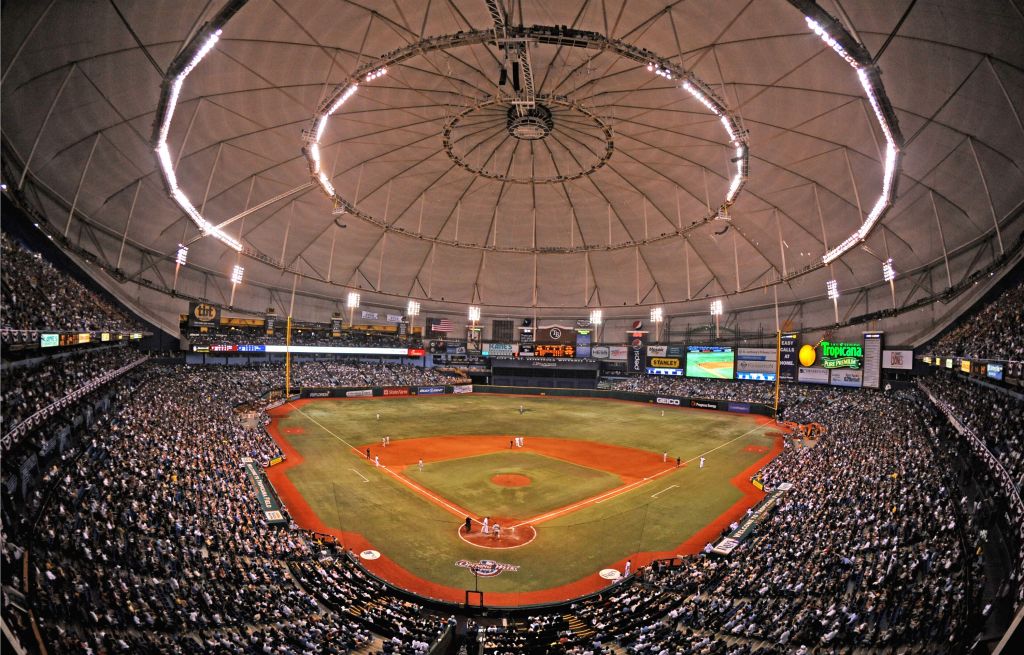MLB
The 3 Largest and 3 Smallest MLB Stadiums by Capacity

Visiting one of MLB’s 30 ballparks is an unforgettable part of America’s pastime. Two stadiums still stand from the 1910s (Fenway Park and Wrigley Field), while construction gives fans updated experiences at new arenas like the Texas Rangers’ Globe Life Stadium, built in 2020.
Ballpark designs vary based on which team you root for — grass vs. turf, open vs. retractable roof — but MLB owners always prioritize an arena’s seating. So which MLB stadiums are the largest and smallest based on capacity? Here are the top three in each category:
The 3rd-smallest MLB stadium: LoanDepot Park
- Capacity: 36,742
- Location: Miami, Florida
- Team: Miami Marlins
- Built: 2012
- Roof type: Retractable
- Surface: Artificial turf (Shaw Sports B1K)
- Distance to center field: 407 feet
Sharing Joe Robbie Stadium with the Miami Dolphins for 18 years created problems for Marlins fans. So the move to Marlins Park (now LoanDepot Park) in 2012 was a refreshing respite from the tropical weather, Dolphins’ colors, and poor visibility way up in the football bleachers.
Once the site of the Miami Hurricanes Orange Bowl, Marlins Park became the first LEED Gold Certified MLB stadium, reports MLB.com. (Target Field, Oracle Park, and Nationals Park have this designation as well.) Maxing out at 36,742 baseball fans, Marlins Park was acquired by a group of investors, including Derek Jeter and Bruce Sherman, in 2017.
Then, in 2021, LoanDepot Park received its naming rights from the mortgage lender. In the five years before its name change, the stadium replaced its grass with turf — the sod kept turning brown from lack of sunlight — and moved in its center- and right-center field fences.
The 2nd-smallest MLB stadium: Progressive Field
- Capacity: 34,830
- Location: Cleveland, Ohio
- Team: Cleveland Guardians
- Built: 1994
- Roof type: Open
- Surface: Kentucky Bluegrass
- Distance to center field: 410 feet
Progressive Field’s capacity peaked in 2010 at 45,569 people. However, subsequent renovations and reconfigurements have knocked that number down to 34,830, making the Guardians’ residence the second-smallest MLB stadium. “The Jake” was built in 1994 to give the then-Cleveland Indians a home of their own. They’d shared Cleveland Stadium with the Browns since 1993.
In 1995, Jacobs Field (now Progressive) set an MLB record by selling out 455 consecutive games — that’s five seasons and 81 home games at max capacity. Although the Red Sox’s Fenway Park broke the record in 2008, reports Bleacher Report, the Guardians retired jersey No. 455 to celebrate Progressive Field’s accomplishment.
The smallest MLB stadium: Tropicana Field
- Capacity: 25,000
- Location: St. Petersburg, Florida
- Team: Tampa Bay Rays
- Built: 1990
- Roof type: fixed
- Surface: Artificial turf (Shaw Sports)
- Distance to center field: 404 feet
Since 2019, Tropicana Field has had the ability to host around 25,000 MLB fans due to the closing of its upper decks for a remodel. Since the team’s average attendance pre-renovations were 14,000, this isn’t too worrying. However, Tampa Bay Rays fans hope for a fresh look once the team’s lease runs through 2027.
Orlando Magic cofounder Pat Williams tried to lure the franchise to Orlando with little luck. According to WFLA, St. Petersburg Mayor Ken Welch plans to develop Tropicana Field’s Historic Gas Plant District into a more amenable region for baseball fans, who have criticized the stadium’s location, 20 miles from downtown Tampa and even farther from larger populations north and east of Tampa.
In the meantime, Tropicana Field is one of the 21 MLB ballparks with corporate naming rights. In 1996, nearby juice company Tropicana Products agreed to a 30-year deal, which ends around the same time as its lease.
Regardless of this small stadium’s future, we hope the franchise keeps its 10,000-gallon “Touch Tank” filled with three species of rays and located right over the right-center field. Sponsored by the Florida Aquarium, MLB fans can visit the aquarium for free during Rays games.
The 3rd-largest MLB stadium: Chase Field
- Capacity: 48,405
- Location: Phoenix, Arizona
- Team: Arizona Diamondbacks
- Built: 1998
- Roof type: Retractable
- Surface: Artificial turf (ShawTurf)
- Distance to center field: 407 feet
Finished for Opening Day of 1998, Chase Field, home to the D-Backs, is the third-largest MLB stadium with a capacity for 48,405 fans. The retro-modern architecture reminds some of an airport hangar, highly magnified, according to Ballparks of Baseball. The natural grass field was replaced with synthetic turf following the 2018 season. Centerfield measures 407 feet, and the entire stadium is air-conditioned.
Chase Field sports All-You-Can-Eat seats, located on the Diamond Level starting as the gates open, where fans enjoy unlimited ballpark food, including Ball Park hot dogs, popcorn, and peanuts, with soda and bottled water. The food and drink stop flowing in the 7th inning.
The 2nd-largest MLB stadium: Coors Field
- Capacity: 50,144
- Location: Denver, Colorado
- Team: Colorado Rockies
- Built: 1995
- Roof type: Open
- Surface: Grass (Kentucky bluegrass)
- Distance to center field: 415 feet
As an expansion team, the Colorado Rockies spent their first two seasons, 1993-94, at the Denver Broncos’ Mile High Stadium. Denver’s first MLB franchise quickly moved to their own place in 1995, becoming the first baseball-only park in the National League since Dodger Stadium was built 33 years prior.
Take a seat at Coors Field, and you’ll notice Row 20, the purple row of seats encircling the entire stadium and marking exactly one mile above sea level. The ballpark is also known for being home-run-friendly, with baseballs traveling 5%-10% farther due to Denver’s elevation and semi-arid conditions, as Denver 7 reports. While constructing Coors Field, the outfield fences were set farther back from home plate.
The largest MLB stadium: Dodger Stadium
- Capacity: 56,000
- Location: Los Angeles, California
- Team: Los Angeles Dodgers
- Built: 1962
- Roof type: Open
- Surface: Grass (Santa Ana Bermuda)
- Distance to center field: 395 feet
In 1962, the Los Angeles Dodgers received their stadium, built in Chavez Ravine near downtown and with access to many LA freeways. Now, Dodger Stadium is the third-oldest ballpark in MLB (after Fenway Park and Wrigley Field) and the oldest West of the Mississippi. With a capacity of 56,000, it can accommodate more than double the number of fans at Tampa’s Tropicana Stadium.
Modern in its heyday, and through continual upkeep, Dodger Stadium often sees sellout or near-sellout crowds. The field is made of natural grass; a full-time gardening crew cares for the plant life. Designed to resist earthquakes, the stadium has several unique design features including terraced parking lots that minimizes the use of ramps and symmetrical outfield proportions — only three MLB ballparks still have the latter.











